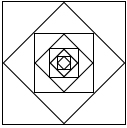Lesson 4
1. Lesson 4
1.14. Lesson 4 Summary
Module 1: Sequences and Series
Lesson 4 Summary

In this lesson you investigated the following questions:
- How are arithmetic sequences and geometric sequences similar and different?
- How is compound interest an application of geometric sequences?
You studied geometric sequences. The following table summarizes the similarities and differences between arithmetic and geometric sequences.
| Arithmetic Sequence | Geometric Sequence | ||
An arithmetic sequence is a sequence in which the next term equals the preceding term plus or minus a common difference (d).
Recall the general term formula is
where a is the first term, n is the position of the term, and d is the common difference. Common difference: d = t2 − t1 (or any term minus the previous term) |
A geometric sequence is a sequence in which the next term is equal to the preceding term multiplied or divided by a constant ratio (r).
Recall the general term formula is
where a is the first term, n is the position of the term, and r is the common ratio. |
Geometric sequences can be applied in many situations. One such situation is compound interest. You compared the formula for compound interest, A = P(1 + i)n, to the general term. In the case of compound interest, the first term is the principal and the common ratio is 1 + i.
You also compared simple-interest growth to compound-interest growth. Over time, an investment earning compound interest increases in value more rapidly than the same investment earning simple interest.
In the next lesson you will extend your study of geometric sequences to geometric series.